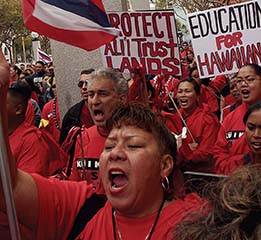American Issues  Connector: Territorial Expansion of the United States
Connector: Territorial Expansion of the United States

Protesters want to restore the native sovereignty of the Hawaiian Islands.
TRACK THE ISSUE
![]() Should the United States expand its territory?
Should the United States expand its territory?
The United States has expanded its territory many times. It has done so through various means, including negotiation, treaty, annexation, and war. But territorial expansion has often aroused strong debate among Americans. Use the timeline below to explore this enduring issue.
-
1803 Louisiana Purchase
Jefferson buys Louisiana Territory despite doubts about constitutionality.
-
1845 Texas Annexation
Texas joins the Union despite opposition from Mexico and nonslave states.
-
1848 Mexican Cession
United States gains vast lands in the Southwest as a result of war with Mexico.
-
1867 Alaska Purchase
Critics say Alaska is an icebox and call the deal “Seward’s Folly.”
-
1893 Hawaiian Revolt
American planters overthrow Queen Liliuokalani and pave way to annexation in 1898.
-
1898 Spanish-American War
Victory over Spain puts Cuba, Puerto Rico, the Philippines, and Guam under U.S. control.

Queen Liliuokalani
DEBATE THE ISSUE
Native Hawaiian Sovereignty In 1898, the United States annexed Hawaii without the consent of native Hawaiians. In recent years, some Hawaiians have called for the return of native sovereignty. One possible solution is the establishment of some form of self-rule for natives, much like the “nation within a nation” status of Native Americans.
“For the overwhelming majority of Hawaiians, justice means political status and federal recognition, the restoration of our inherent sovereignty and redress from the United States for the illegal overthrow of the Kingdom of Hawaii…. Although there are more Hawaiians than … any other native peoples in the United States, Hawaiians have remained without recognition of our right to self-govern.”
—Clayton Hee, Office of Hawaiian Affairs
“Would the citizens of [a] Native Hawaiian government—like reservation Indians—be immune from state laws, regulations and taxes? … If Congress were to create a separate tribal government for Native Hawaiians, it would be imposing just such a system on the people of Hawaii. Persons of different races, who live together in the same society, would be subject to different legal codes. This … is a recipe for permanent racial conflict.”
—John Kyl, senator from Arizona
 TRANSFER Activities
TRANSFER Activities
- Compare How do the two speakers differ on the issue of self-rule for Hawaiians?
- Analyze If Native Hawaiians gain sovereignty, how would their lives change?
- Transfer Use the following Web site to see a video, try a WebQuest, and write in your journal. Web Code: neh-7802




